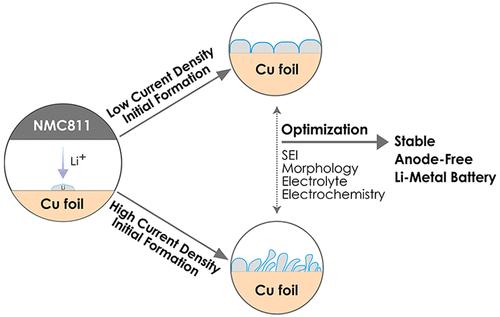形成率对无阳极金属锂电池稳定性的影响
IF 18.2
1区 材料科学
Q1 CHEMISTRY, PHYSICAL
引用次数: 0
摘要
无阳极锂离子电池(AFB)是一种提高电池能量密度的有前途的技术,这种电池用铜集流器代替传统的阳极来板化和剥离锂。此外,AFB 比竞争对手的锂金属阳极和固态电池更安全、更容易制造。然而,AFB 运行过程中发生的锂库存损失限制了其使用寿命和实际应用。在这项研究中,我们发现 AFBs 形成过程中使用的电流密度对电池的循环稳定性有很大影响。我们根据实验和计算观察到的与镀层锂的形态变化和固体电解质间相的化学成分相关的阈值,优化了形成方案。与需要缓慢形成周期的石墨阳极不同,AFB 在最高电流密度下形成时可避免树枝状锂的形成,从而改善循环性能。我们验证了这种优化形成电流密度的策略对三种不同的电解质配方都有效,因此为优化 AFB 的形成规程提供了直接的通用原理。本文章由计算机程序翻译,如有差异,请以英文原文为准。

Effect of the Formation Rate on the Stability of Anode-Free Lithium Metal Batteries
Anode-free Li-ion batteries (AFBs), where a Cu current collector is used to plate and strip Li instead of a classic anode, are promising technologies to increase the energy density of batteries. In addition, AFBs are safer and easier to manufacture than competing Li-metal anodes and solid-state batteries. However, the loss of Li inventory that occurs during the operation of AFBs limits their lifespan and practical application. In this study, we find that, in particular, the current density used during the formation of AFBs has a considerable impact on the cycling stability of the cell. We optimize the formation protocol based on experimental and computational observations of thresholds associated with morphological changes in the plated Li and the chemical composition of the solid–electrolyte interphase. Unlike graphite anodes, which require slow formation cycles, AFBs exhibit improved cycling behavior when formed at the highest current densities that avoid dendritic Li formation. We verify that this strategy for optimizing the formation current density is effective for three different electrolyte formulations and, therefore, provides a straightforward universal rationale to optimize the formation protocols for AFBs.
求助全文
通过发布文献求助,成功后即可免费获取论文全文。
去求助
来源期刊

ACS Energy Letters
Energy-Renewable Energy, Sustainability and the Environment
CiteScore
31.20
自引率
5.00%
发文量
469
审稿时长
1 months
期刊介绍:
ACS Energy Letters is a monthly journal that publishes papers reporting new scientific advances in energy research. The journal focuses on topics that are of interest to scientists working in the fundamental and applied sciences. Rapid publication is a central criterion for acceptance, and the journal is known for its quick publication times, with an average of 4-6 weeks from submission to web publication in As Soon As Publishable format.
ACS Energy Letters is ranked as the number one journal in the Web of Science Electrochemistry category. It also ranks within the top 10 journals for Physical Chemistry, Energy & Fuels, and Nanoscience & Nanotechnology.
The journal offers several types of articles, including Letters, Energy Express, Perspectives, Reviews, Editorials, Viewpoints and Energy Focus. Additionally, authors have the option to submit videos that summarize or support the information presented in a Perspective or Review article, which can be highlighted on the journal's website. ACS Energy Letters is abstracted and indexed in Chemical Abstracts Service/SciFinder, EBSCO-summon, PubMed, Web of Science, Scopus and Portico.
 求助内容:
求助内容: 应助结果提醒方式:
应助结果提醒方式:


